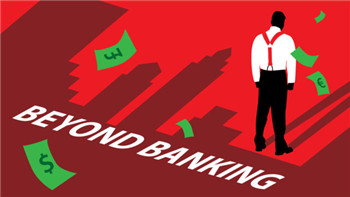(单词翻译:单击)

It is more than seven years since the height of the financial crisis, but the run of disastrous banking news during the past few weeks has revived bad memories. Profit warnings, mass job cuts, share price plunges and defensive capital raisings have abounded.
全球金融危机最严重时期已过去7年多了,但过去几周,一轮灾难性的银行业消息唤醒了过去那些痛苦的回忆。盈利预警、大规模裁员、股价暴跌以及防御性融资,这样的消息不绝于耳。
With the aftershocks of 2008 still hitting the global economy — and central banks in the US and UK shying away from normalising ultra-accommodative monetary policies — banks, formerly seen as the powerhouses of growth, are under pressure on every side. Regulation is piling up. Competitors are stealing business. And many lenders are shrinking fast. Is banking in terminal decline?
2008年金融危机的余波仍在影响全球经济以及美国和英国央行(它们正回避超宽松货币政策的正常化),曾被视为增长推动力的银行正面临各方压力。监管力度在增强。竞争对手正窃取业务。很多银行正快速收缩规模。银行业是否正处于穷途末路?
It is certainly in turmoil. Hit by challenging markets and onerous post-crisis regulation, bank profitability has been squeezed hard. Today, even JPMorgan Chase, the most profitable Wall Street bank on recent performance, generates a return on equity of just 12 per cent. That compares with the industry average of about 25 to 30 per cent pre-crisis.
银行业肯定正处于动荡之中。受到具有挑战性的市场以及危机过后严格监管的影响,银行利润率一直被严重挤压。如今,甚至连根据最近表现堪称华尔街最赚钱银行的摩根大通(JPMorgan Chase),也仅仅取得了12%的股本回报率。而危机之前的行业平均水平约为25%至30%。
A decade ago, investors would have slammed JPM’s chief executive Jamie Dimon for such a dismal return.
如果摩根大通10年前取得如此惨淡的回报率,投资者会狠狠抨击该银行的首席执行官杰米戴蒙(Jamie Dimon)。
Goldman Sachs , another of the banks that has prospered relative to rivals, suffered a near 40 per cent slump in third-quarter net income. Goldman’s ROE is now just 7 per cent.
另一家较竞争对手表现较佳的银行高盛(Goldman Sachs)第三季度净利润下滑近40%,股本回报率目前仅为7%。
There are three simplistic schools of thought about what is going on. The first theory is that this is just a blip induced by excessive regulation; the second, that it is merely a return to normal after an exceptional pre-crisis boom; the third suggests the slow death of banking.
对于目前的银行业状况有三种简单看法。第一种看法是这只是由过度监管引发的短暂现象;第二种是,这只不过是在危机前的超常繁荣后的常态回归;第三种看法认为银行业正慢慢灭亡。
Many bankers see evidence of the first theory in Europe, where politicians and regulators have recently signalled a willingness to relax certain new rules, for example regarding the obligatory “ringfencing” of retail banking from riskier investment banking in the UK. “One of the things that European [policymakers] have done, which is quite damaging to the infrastructure, is reining back the European investment banks,” says Colm Kelleher, investment banking chief at Morgan Stanley.
很多银行人士在欧洲看到了第一种看法的证据,在这里,政治人士和监管者最近表示愿意放松某些新规,例如英国有关将零售银行业强制性“圈护”起来、与风险较高的投行业务隔离的规定。摩根士丹利(Morgan Stanley)投行业务主管科尔姆凯勒尔(Colm Kelleher)表示:“欧洲(政策制定者)实行的对基础设施造成相当大破坏的一个举措是,约束欧洲投资银行。”
Other bankers cling to the second argument — that we are experiencing a return to normal. Sergio Ermotti , UBS chief executive, says: “When we look back to the mid-90s [and] over the last 15 years, we saw a lot of banks doing a me-too strategy, trying to be everything to everybody, changing their DNAs, doing things they weren’t equipped to do. [That] was the anomaly.”
还有一些银行人士倾向于第二种观点:我们正经历常态回归。瑞银(UBS)首席执行官塞尔吉奥埃尔默蒂(Sergio Ermotti)表示:“当我们回顾上世纪90年代中期(以及)过去15年时,我们看到很多银行在实行跟随战略(me-too strategy),试图为所有人提供无所不包的服务,改变银行自己的DNA,做一些它们没有能力做的事情。(这)不正常。”
UBS has probably gone further and faster than any other bank to focus on its strengths and ditch businesses that are no longer economic, cutting half its assets and a quarter of its staff since 2007.
在关注自身优势以及放弃不再具有经济效益的业务方面,瑞银或许比其他银行做的更多而且速度也更快,自2007年以来,瑞银削减了一半的资产,裁员四分之一。
“The banking model is in many ways getting more like we’re turning the clock back to the early 1990s,” agrees Philipp Hildebrand, former head of the Swiss National Bank and now a senior executive at asset manager BlackRock. “When the history books are written, the aberration will not be the past crisis but the 15 years running up to 2007.”
“从很多角度来看,现在的银行业模式更像是我们把时钟拨回到上世纪90年代初,”瑞士央行(SNB)前行长、现任资产管理公司贝莱德(BlackRock)高管的菲利普希尔德布兰德(Philipp Hildebrand)认为,“在撰写历史书时,作为反常现象被写入的将不是过去这次危机,而是2007年之前的15年。”
The third, and most extreme, thesis about the mayhem in banking — that much of the industry is now in terminal decline — is peddled by those who are challenging banks’ traditional ways of doing things.
对于银行业乱象的第三种(也是最极端)的看法认为,银行业正大范围走入穷途末路,这是由那些正挑战传统银行业的人士提出的。
Peer-to-peer or marketplace lenders — online platforms that match lenders with borrowers — are one of several upstart fraternities that believe they can steadily chip away at many of the banking industry’s longstanding functions.
个人对个人(P2P)或市场贷款机构(将贷款人与借款人匹配的在线平台)是几个新贵群体之一,它们认为自己可以稳定侵蚀掉银行业的许多历史悠久的职能。
“Clearly banks are under attack on multiple fronts,” says Renaud Laplanche, chief executive of the world’s biggest P2P platform, San Francisco-based Lending Club. “In credit, there is market-based lending. In payments, PayPal is [dominant]. In asset management, you have all the robo advisers. There is a massive competitive threat from tech companies.”
“显然,银行正在多个方面遭遇围攻,”全球最大P2P贷款平台、总部位于旧金山的贷款俱乐部(Lending Club)的首席执行官雷诺拉普朗什(Renaud Laplanche)表示,“在信贷领域,出现了基于市场的贷款。在支付领域,PayPal(占据主导地位)。在资产管理领域,出现了机器人顾问。银行面临来自科技公司的大规模竞争威胁。”
The main advantage new challengers have, says Mr Laplanche, is straightforward: they are unencumbered by old expensive systems, and new regulatory overheads. “Our operating cost is 2 per cent of assets compared with 7 per cent at a typical bank,” he says.
拉普朗什表示,新的挑战者具备的主要优势简单明了:它们不受成本高昂的旧系统以及新的监管费用的阻碍。他表示:“我们的营运成本为资产的2%,而银行平均为7%。”


